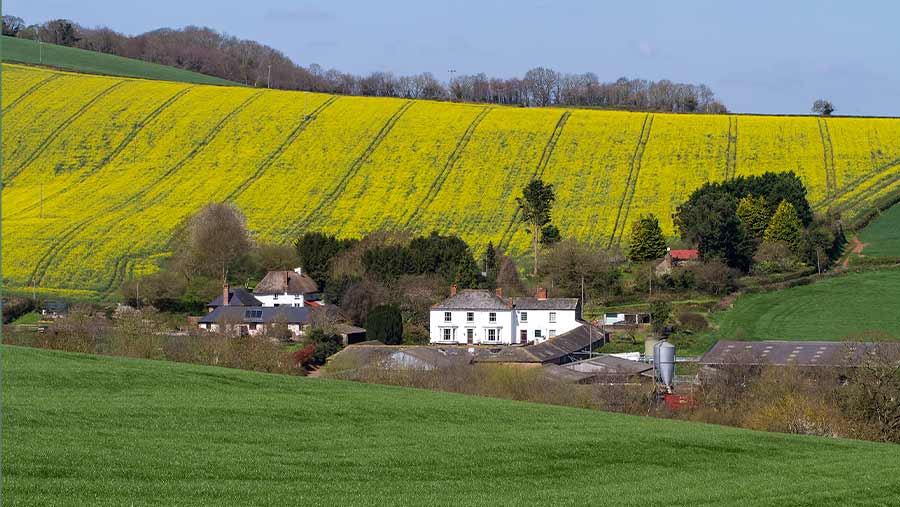Rollover money was strong influence in 2015 South West farmland market
 Court Barton, a 295-acre dairy farm near Crediton..
Court Barton, a 295-acre dairy farm near Crediton.. Agents selling farmland across south-west England say 2016 will be a challenging year with uncertainty around EU membership making buyers more cautious, although they expect demand and prices to hold firm.
The past 12 months have seen a large range of land values, caused in part by location, but also influenced by buyers with rollover funds and investors, in Wiltshire and Dorset in particular.
Sales were mixed, with some agents saying 2015 was a busy year and others saying it suffered from a lack of farms.
Farmers Weekly spoke to agents across the region to find out more.
Land market values – south-west England
| 12 months to end of 2014 | 12 months to end of 2015 | |
| No. of farms publicly advertised nationally (south-west England) | 94 (20,012 acres) | 103 (18,294 acres) |
| Average value – all types of farmland | £7,000 | £7,100 |
| Average value – prime arable land | £8,600 | £8,900 |
| Average value – Grade 3 arable farmland | £7,500 | £7,500 |
| Average value – Grade 3 grassland | £6,400 | £6,500 |
| Source: Savills | ||
Andrew Dodds, Stags Farm Agency, Exeter
- Within Cornwall, Devon and Dorset, 2015 was possibly the busiest spring for bringing farms and land to the market for 10 years. We sold 49% more land in 2015 than in 2014. The second half of the year was much quieter and there were signs that demand may have eased slightly in the last quarter.
- We sense that the market may be a little more cautious in 2016, a natural reflection of farm incomes and commodity prices, but the early signs are for a busy spring.
- Our 2015 sales showed that 74% of buyers were from the West Country and the majority were active farming businesses. Residential buyers from the South East were very active but they didn’t appear to want whole farms. This led to many farms being offered for sale in lots.
- Location was the main driver for purchasers, and an accessible arable farm with level, Grade 1 or Grade 2 land could expect a lot of interest in 2016.
Charlie Evans, Strutt & Parker, Salisbury
- The key trend in 2015 was increased interest from buyers with rollover money. Those with a windfall from development land have £2m-£5m to spend so are interested in blocks of 250-500 acres.
- Wiltshire saw the highest average arable land price at £9,700/acre, although some sales reached £12,000/acre. Average figures in Devon and Cornwall were lower at £8,640/acre.
- Sales attracted a huge range of values. A lack of supply and continued demand from tax-driven buyers will mean that the land price will not crash in 2016. I expect the average price to remain static at best and fall by 10% at worst. There will still be some “super sales”, which attract competitive bids and reach very high prices.
- Many people are quite gloomy about the 2016 land market but there is strong demand from the lifestyle market and from a growing number of tax-driven buyers. I expect there will be good interest in land next year, albeit from lifestyle-led buyers rather than pure farmers.
David Hebditch, Humberts, Taunton
- We have seen a shortage in the supply of commercial farms in east and mid-Devon, Dorset and Somerset. Supply has been more plentiful in west Devon.
- In 2015, only 25% of purchasers were traditional farming businesses. A further 37% were mixed businesses, which already had an established farming component. The remaining 38% comprised lifestyle purchasers.
- Although falling commodity prices and uncertainty over the CAP and Europe affected some purchasers’ confidence in 2015, we feel these factors will be felt more in the 2016 market.
- But many purchasers have taken a long-term view, especially in respect of the purchase of adjoining holdings. The market has also continued to benefit from the presence of a number of high net-worth individuals and tax-driven purchases associated with rollover money.
- The price differential between good- and poorer-quality holdings has continued to grow and we expect this to continue in 2016.
Richard Nocton, Woolley & Wallis, Malborough
- Wiltshire farmland has maintained its strong demand, with good levels of interest and the market continuing to pay a higher premium for quality blocks of arable land.
- There is much anticipation for more off-market activity in 2016 from investors and the increasing use of a self-invested personal pension for land purchases.
- Land supply has been down over the past 12 months but I would expect to see this change and for the volume of land available for sale to increase this year with the quality chalk arable downland remaining the market leader. Smaller parcels of heavier land will take longer to sell.
See more
